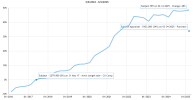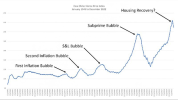-
Welcome to AppraisersForum.com, the premier online
 community for the discussion of real estate appraisal. Register a free account to be able to post and unlock additional forums and features.
community for the discussion of real estate appraisal. Register a free account to be able to post and unlock additional forums and features.
You are using an out of date browser. It may not display this or other websites correctly.
You should upgrade or use an alternative browser.
You should upgrade or use an alternative browser.
New USPAP Q&As published March 6, 2025
- Thread starter timd354
- Start date
- Status
- Not open for further replies.
timd354
Elite Member
- Joined
- Jan 11, 2008
- Professional Status
- Certified Residential Appraiser
- State
- Maryland
If your sales are from December but your value is in Feb or March and you know the prices are wanting to rise or could rise but you don't have any sales to support it, you have to project based upon what the overall market is doing. Otherwise, you would have usable sales from days or just a few weeks earlier that would support the value without a market conditions adjustment.
Appraisers should be able to evaluate market trends by looking at inventory trends, DOM trends, pending sales, listings, Sale Price to List Price ratio trends, etc., in addition to closed sales. Everyone knows, that in many markets, there is typically an increase in purchase demand in the spring and decreased purchase demand at various other times of the year and appraisers should be able to do better than just throw up their hands and say "I don't know" when it comes to evaluating these trends and marking a market condition adjustment when warranted.
FYI, one of the arguments that I heard someone at the GSE's make regarding appraisal waivers is that their models are better than appraisers in detecting market trends and are quicker to detect changes in market trends/market direction. I am not saying that I agree with their argument, but your post certainly feeds into that mindset.
TerryRohrer
Elite Member
- Joined
- Aug 13, 2005
- Professional Status
- Certified General Appraiser
- State
- Montana
So show us how this works. If inventories are declining, does that always prove that prices are increasing (I have seen the opposite). If doms are increasing, does that always mean prices are falling? If prices on pending sales can't be verified, what does that information tell you other than there is an offer on the table? If listing prices are increasing but properties are not selling, does that always mean prices are increasing? If sales price to list price ratios are stable, does that always mean prices are stable? And how do you translate increasing doms to a dollar or percentage change in values. It is easy to throw this crap at the wall, but I challenge you to provide a single source where these techniques are demonstrated in a manner that the majority of appraisers will agree with (and remember, experience is not support).Appraisers should be able to evaluate market trends by looking at inventory trends, DOM trends, pending sales, listings, Sale Price to List Price ratio trends, etc., in addition to closed sales. Everyone knows, that in many markets, there is typically an increase in purchase demand in the spring and decreased purchase demand at various other times of the year and appraisers should be able to do better than just throw up their hands and say "I don't know" when it comes to evaluating these trends and marking a market condition adjustment when warranted.
And if it is critical to demonstrate trends as of the effective date of the appraisal, and make market conditions adjustments to that date, how does the use of an HPI where the most recent data is 60 to 90 days old accomplish that? And why don't the HPIs include trends through the current date? The GSEs have opined that everything other than closed sales can be relied on to accomplish that so why haven't they done it themselves?
GSE folks make a lot of claims that can't be verified because they hide the data. Not really very different than appraisers who suggest their conclusions are based on experience, except that there are mechanisms to make appraisers prove it.FYI, one of the arguments that I heard someone at the GSE's make regarding appraisal waivers is that their models are better than appraisers in detecting market trends and are quicker to detect changes in market trends/market direction. I am not saying that I agree with their argument, but your post certainly feeds into that mindset.
Last edited:
glenn walker
Elite Member
- Joined
- Oct 11, 2006
- Professional Status
- Certified Residential Appraiser
- State
- California
Theres not much hidden data that would help apprasers anyway. The data they collect is mostly from appraisers and the data that's not is used for portfolios management and risk.So show us how this works. If inventories are declining, does that always prove that prices are increasing (I have seen the opposite). If doms are increasing, does that always mean prices are falling? If prices on pending sales can't be verified, what does that information tell you other than there is an offer on the table? If listing prices are increasing but properties are not selling, does that always mean prices are increasing? If sales price to list price ratios are stable, does that always mean prices are stable? And how do you translate increasing doms to a dollar or percentage change in values. It is easy to throw this crap at the wall, but I challenge you to provide a single source where these techniques are demonstrated in a manner that the majority of appraisers will agree with (and remember, experience is not support).
GSE folks make a lot of claims that can't be verified because they hide the data. Not really very different than appraisers who suggest their conclusions are based on experience, except that there are mechanisms to make appraisers prove it.
TerryRohrer
Elite Member
- Joined
- Aug 13, 2005
- Professional Status
- Certified General Appraiser
- State
- Montana
I'm not concerned that they have anything that would help appraisers. I'm concerned because they are liars and thieves and when they pronounce what their "analysis" shows, it can neither be trusted nor verified. And, as we know, their conclusions can be politically motivated (see Freddie's Research Note that begat the narrative that appraisers are racists). And only a damn fool would argue the GSEs care about veracity when their HPI garbage is acceptable support for anything. A WAG estimate is likely to be superior than a statewide market conditions adjustment.Theres not much hidden data that would help apprasers anyway. The data they collect is mostly from appraisers and the data that's not is used for portfolios management and risk.
- Joined
- May 20, 2011
- Professional Status
- Certified General Appraiser
- State
- Minnesota
Fannie's zip code level HPI benchmarks the prior sale price to price inflation at +48%. However, CU calculates the current appraisal at only +34% because it divides the increase by the numerator not the denominator. I've tested this across many markets and get the same miscalculation.
Does this instill confidence in CU?

Does this instill confidence in CU?

Fritz in NY
Senior Member
- Joined
- Dec 16, 2004
- Professional Status
- Certified Residential Appraiser
- State
- New York
Did anyone suggest Data Mining? Teaching AI what to do and how it is done. Every Region, Every State, Every line item. A lot of data that we, as appraisers seem to be "Giving Away" to AI. We are eliminating ourselves. With a simple CU run, all data can be reconciled, no need for our comments.
glenn walker
Elite Member
- Joined
- Oct 11, 2006
- Professional Status
- Certified Residential Appraiser
- State
- California
Don't want to bust your bubble but the Money Center Banks and the GSEs and virtually everyone including legacy media have always been lying thieves. Is it possible you were just to busy to realize this and now you see more clearly ?I'm not concerned that they have anything that would help appraisers. I'm concerned because they are liars and thieves and when they pronounce what their "analysis" shows, it can neither be trusted nor verified. And, as we know, their conclusions can be politically motivated (see Freddie's Research Note that begat the narrative that appraisers are racists). And only a damn fool would argue the GSEs care about veracity when their HPI garbage is acceptable support for anything. A WAG estimate is likely to be superior than a statewide market conditions adjustment.
Joe Flacco
Elite Member
- Joined
- Jul 31, 2013
- Professional Status
- Certified Residential Appraiser
- State
- Maryland
Fannie's zip code level HPI benchmarks the prior sale price to price inflation at +48%. However, CU calculates the current appraisal at only +34% because it divides the increase by the numerator not the denominator. I've tested this across many markets and get the same miscalculation.
Does this instill confidence in CU?
View attachment 97700
This reminds me of the FRED median sale price comparison with case shiller index. Index showing continuing to increase trend while the median sale price trend showing slightly lower year over year since 2022.
The reliability of these indicies are really questionable based on what you are saying.
TerryRohrer
Elite Member
- Joined
- Aug 13, 2005
- Professional Status
- Certified General Appraiser
- State
- Montana
Uh, I never had any notion they were anything but.Don't want to bust your bubble but the Money Center Banks and the GSEs and virtually everyone including legacy media have always been lying thieves. Is it possible you were just to busy to realize this and now you see more clearly ?
- Status
- Not open for further replies.


